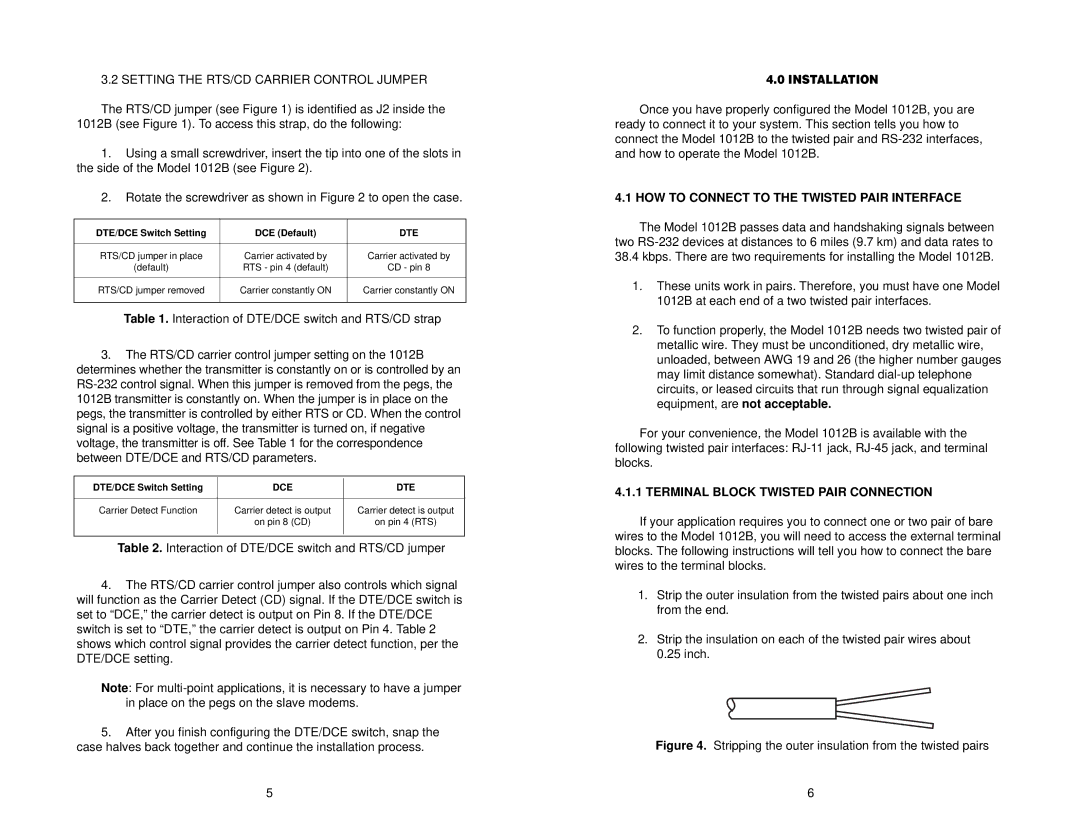3.2 SETTING THE RTS/CD CARRIER CONTROL JUMPER
The RTS/CD jumper (see Figure 1) is identified as J2 inside the
1012B (see Figure 1). To access this strap, do the following:
1.Using a small screwdriver, insert the tip into one of the slots in the side of the Model 1012B (see Figure 2).
2.Rotate the screwdriver as shown in Figure 2 to open the case.
DTE/DCE Switch Setting | DCE (Default) | DTE |
|
|
|
RTS/CD jumper in place | Carrier activated by | Carrier activated by |
(default) | RTS - pin 4 (default) | CD - pin 8 |
|
|
|
RTS/CD jumper removed | Carrier constantly ON | Carrier constantly ON |
|
|
|
Table 1. Interaction of DTE/DCE switch and RTS/CD strap
3.The RTS/CD carrier control jumper setting on the 1012B determines whether the transmitter is constantly on or is controlled by an
DTE/DCE Switch Setting | DCE | DTE |
|
|
|
Carrier Detect Function | Carrier detect is output | Carrier detect is output |
| on pin 8 (CD) | on pin 4 (RTS) |
|
|
|
Table 2. Interaction of DTE/DCE switch and RTS/CD jumper
4.The RTS/CD carrier control jumper also controls which signal will function as the Carrier Detect (CD) signal. If the DTE/DCE switch is set to “DCE,” the carrier detect is output on Pin 8. If the DTE/DCE switch is set to “DTE,” the carrier detect is output on Pin 4. Table 2 shows which control signal provides the carrier detect function, per the DTE/DCE setting.
Note: For
5.After you finish configuring the DTE/DCE switch, snap the case halves back together and continue the installation process.
4.0 INSTALLATION
Once you have properly configured the Model 1012B, you are ready to connect it to your system. This section tells you how to connect the Model 1012B to the twisted pair and
4.1 HOW TO CONNECT TO THE TWISTED PAIR INTERFACE
The Model 1012B passes data and handshaking signals between two
38.4kbps. There are two requirements for installing the Model 1012B.
1.These units work in pairs. Therefore, you must have one Model 1012B at each end of a two twisted pair interfaces.
2.To function properly, the Model 1012B needs two twisted pair of metallic wire. They must be unconditioned, dry metallic wire, unloaded, between AWG 19 and 26 (the higher number gauges may limit distance somewhat). Standard
For your convenience, the Model 1012B is available with the following twisted pair interfaces:
4.1.1 TERMINAL BLOCK TWISTED PAIR CONNECTION
If your application requires you to connect one or two pair of bare wires to the Model 1012B, you will need to access the external terminal blocks. The following instructions will tell you how to connect the bare wires to the terminal blocks.
1.Strip the outer insulation from the twisted pairs about one inch from the end.
2.Strip the insulation on each of the twisted pair wires about 0.25 inch.
Figure 4. Stripping the outer insulation from the twisted pairs
5 | 6 |
